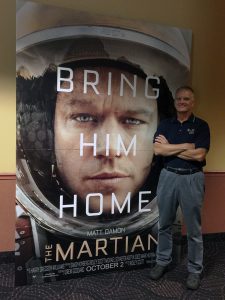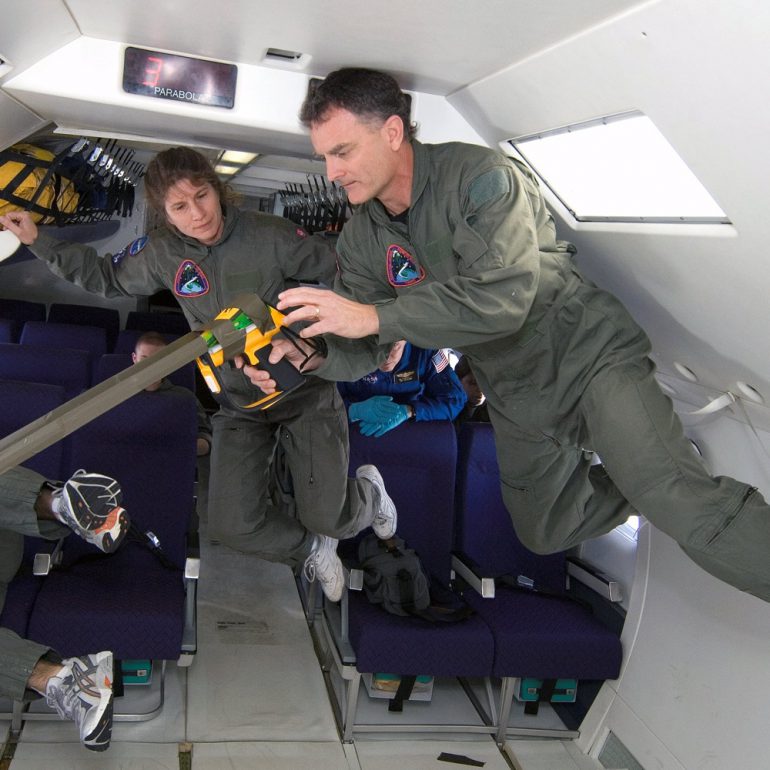“The Martian” is giving away a secret: science is really, really cool.
The movie is funny, irreverent, dramatic, emotional and, interestingly, more science than science fiction, says University of Florida space plants expert Rob Ferl, who agreed to watch the Gainesville premier Thursday night for Explore magazine, ahead of the movie’s national release today.
And while Matt Damon is dashing as botanist Mark Watney, the space plants and the science steal the show. Ferl’s review: two thumbs up.
“There are a lot of us in the business that are absolutely celebrating the fact that the botanist, the scientist, got to be the person who figured everything out,” Ferl says.
Science drives the plot, as astronaut-scientist Damon wakes up alone on Mars after his crew leaves him for dead, and he has to figure out how to survive. The scientific method has never been so riveting, but nevertheless, Ferl says the movie stays on track.

“The hero, the protagonist, is a thinker. As he says, you start with the first problem and work that out, then you find the next thing and work that out, until you get to where you need to be,” Ferl says. “That’s the stuff scientists do every day. The idea that you could think your way out of a problem, that’s science.”
Ferl and his colleague Anna-Lisa Paul have been sending plants into space since 1999 to learn about how plants adapt to an environment completely foreign to their evolution. The scientists have learned enough to make Ferl believe the scene in the movie preview of botanist Mark Watney in the midst of rows of thriving plants is not so far in the future.
“Science has been thinking about growing crops on Mars and on the moon and in a big spaceship for decades. We know the math,” Ferl says. “Big chambers have been built where the only way to recycle your nutrients, your water, your air, your oxygen is with the plants beside you in the chamber. Those things have been worked out as part of the concepts of Advanced Life Support.”
All kinds of crops have been grown on orbit, but could you grow potatoes, as Damon does? Ferl says, “Sure, why not?”
In the UF Space Plants Lab, Ferl and Paul have found plants to be remarkably resilient. In a recent experiment, they found that plants may not even need gravity, as has been thought for years. In the weightlessness of the International Space Station, they found that in the absence of gravity to guide root growth, plants will use light, a heartening finding for space travelers hankering to go to the moon or Mars.
Even for Ferl and Paul and other colleagues whose experiments are frequent fliers into space, progress is slow, Ferl says.
“You only get up into space once every few years, even if you’re lucky, but we’ve become good space gardeners, good space biologists by sending our experiments into space on the near-regular basis NASA makes available.”
As a molecular biologist, Ferl says it is exciting to learn the limits of adaptation for organisms like plants. After all, the long-term, ecologically based life support system for humans in space will depend on plants. Their limits are human limits. So when Ferl is sitting in Mission Control and watching genes going on and off inside a plant, he’s learning about adaptations that make human space travel possible.
Unlike humans, plants are rooted in place. They can’t move to get water or sun or to get relief from cold or heat. They must adapt right where they are. What are our limits in the solar system, Ferl asks. Where could terrestrial life that evolved to know only Earth, go? Space biology may hold the answer.
“Everything we currently know as “life” has evolved to live on Earth. To me, it’s incredibly bold to think that a human or a plant could live somewhere else, could live on the moon or on Mars. Are you kidding me?” Ferl says. “There’s no experience, nothing in our toolbox as biological specimens that says we should be able to live on Mars, and yet the farther we go, the more work we do in space, the better we learn that it is very possible. Yes, there are differences in plants in space than on the ground; yes, they have to do some things differently, but they do adapt.
“But I’m just flabbergasted. They do well, they do fine. They do their thing and make leaves and turn light into CO2 into food for us and they’re doing it in space.
“I’m absolutely convinced they can do it on Mars, too. We have to be good gardeners, like Mark Watney, but they can do it,” Ferl says.
Would he go?
“No question about it. Absolutely. Yes,” Ferl says, “yes.”
Although the invitation to Mars may not arrive before his retirement, he says it is not a thousand years in the future or even a hundred. A mission to Mars could be a realistic goal for 2030, maybe 2040, especially considering the announcement Monday by NASA of the discovery of water on Mars.
Ferl says he has seen every movie about Mars that has ever been made, and “The Martian” is in a class by itself. The science fiction trappings – warp drives, replicators, buzzing gizmos that make food appear – are missing, he says. From the Earth to Mars and space in between, each character is in figure-it-out mode and, as a scientist, he likes that.
“We try to be Watney. That’s us, and to have him on the screen doing what we do in real life, that’s pretty cool.”
From NASA to Hollywood, it’s a busy week for the Red Planet.
Related Website:
*NPR’s Science Friday featured Ferl and Paul on September 24, 2015.

